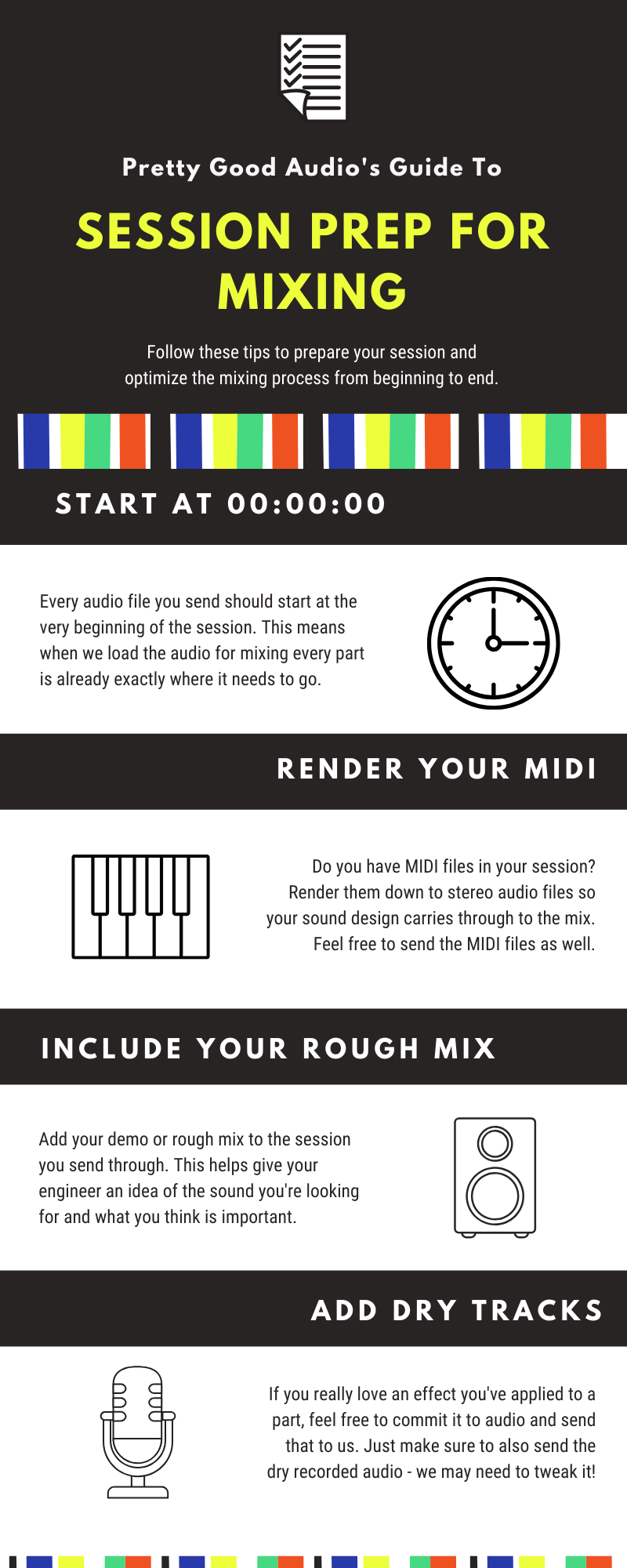Preparing Your Session For Mixing
Sending your session to your engineer is the first step in every project. Here are some tips to make the process seamless and get your mixes delivered faster.
What's the tempo?
When you upload the files, add a note with information about your music as well.
Whether this is an album or a single song, include information like:
- BPM (including any changes as timestamps)
- key
- time signature
- reference tracks (Spotify links or just Artist/Title works fine!)
- sample rate
- any information about the recording that you have on hand ("U87 into 1073 into an 1176/LA-2A. We ran into an API EQ but bypassed it.")
This is information that helps make your mix sound amazing. Adding it to the session you send us saves us having to email you and delay the mix to ask you for it.
Start at Zero
When you're in production mode, it's common to have audio clips scattered throughout your DAW's session file. However, when you send the session for mixing, export them as audio files starting from 00:00:00.
The audio files need to align to 00:00:00 so that when I receive the session and load the files for mixing, everything is already exactly where it needs to be. If you send us those raw audio clips from your recording session, I'll be unable to figure out exactly where they need to go without consulting with you - an avoidable delay.
Render MIDI to Audio
If you are using virtual instruments, make sure to render them to an audio file to send to us. Even if I happen to have the same virtual instrument plugins as you do, rendering to audio locks in your sound design and lets us get straight to work.
It's OK to keep the MIDI files around and send them to us though.
Include a Rough Mix
Do you have a demo for the song? Have you done some mixing on the recorded tracks already to create a rough mix to share around? Send it through to us as well.
We can use your rough mix as a guide for what you're imagining for the mix. Rough mixes also tell us a lot before you have to send your first mix revision - if I hear those guitar lead lines loud and proud in the rough mix I'm more likely to do the same thing in the mix I create for you.
Add the Dry Tracks
If you love the effect you've applied to a part, I'd consider that part of the production rather than a mix decision and do what I can to make use of it. That said, it's always worth sending the dry track without any effects (or printing the effects to their own audio file). That gives us the flexibility to recreate the effect or do some additional editing and processing if it's necessary.
In particular, for the best results I prefer having the option to use dry tracks for the following parts:
- vocals (send all vocal effects as separate audio files)
- drums
- bass (a DI track is perfect along with amp tracks)
Sending a DAW Session
There are some important things to consider when you send your DAW session to us directly (rather than exporting audio files).
- Make sure you consolidate the files for the DAW session so they are all included when you upload it. If I open the session but none of the files can be found, it'll delay your mix as I need to check in with you to get a copy of them.
- Feel free to keep plugins and the like enabled if you like - no need to remove all of that from the session before sending.
- Trim any unnecessary tracks or audio from the session. For example, if you had some spare takes you didn't end up using, don't send them.
In Pro Tools, you can do this consolidation by using the "Save Copy In" feature to bring everything into one folder for sending.
Summary
Preparing your session for mixing is an investment in the final mix. If you spend the time to get the session exported with these guidelines in mind, you'll find your mixes come back faster and you get hit with fewer questions along the way. Win-win!

© 2024 Pretty Good Audio LLC